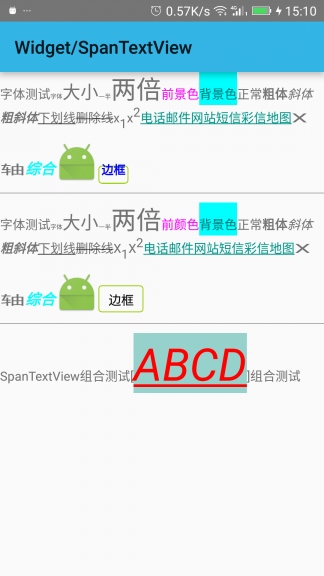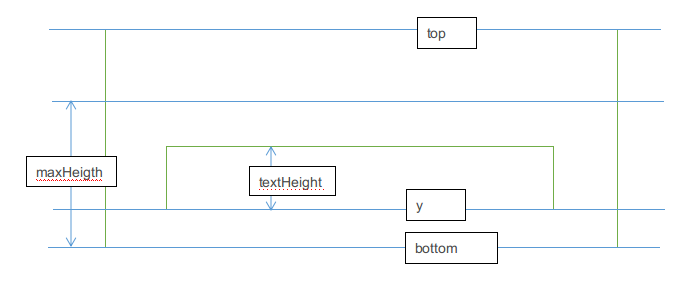先看效果图

是不是没有看出来什么,不要着急,往下看
概述
不可质疑,在android中的TextView是个非常强大的控件,作为一个几年的developer,还是对其知之甚少;最近公司的一个新项目中有这样一个gui需求, 在一行text的显示中显示几个标签,类似于效果图中的边框,要怎么实现呢;总不可能在添加一个TextView显示吧,首先因为标签个数不定,其次这样实现真的 很low,那么怎么办呢,我们肯定会想到android中的SpannableString,这个东西能通过设置span很好的渲染TextView中的局部内容,于是乎自己查了些资料 ,对于我这种懒人,我被惊讶到了,我的天啊,怎么会有这么多的Span定义,有字体、颜色、背景色、大小等等。而且在使用的时候需要指定是什么位置 的text,为了以后工作方便,于是决定,进一步封装;效果和官方定义的效果差不多(如效果图),下面我们就介绍封装过程和使用方法。
优缺点
优点
- 涵盖了大部分的Span
- 可以方便对不同Span组合应用
- 不需要去数对第几个字符设置效果
- 添加了设置背景的功能
- 可以方便设置自定义的Span
缺点
- 和TextView结合不是很好,只能依赖append方法
- 对固定的text引用不佳
实现源码
- 集成自TextView并添加一个spanedable方法
public Spanedable spanedable(CharSequence text) {
return new Spanedable(text);
}- 添加内部类Spanedable,并添加如下属性
private final Map<Object, Integer> spans = new HashMap<>(); //存储组合span
SpannableStringBuilder ss; //
CharSequence text; //需要渲染的text- 内部类Spanedable,构造方法为default,不能外部创建其对象
Spanedable(CharSequence text) {
this.text = text;
this.ss = new SpannableStringBuilder(text);
}- 大部分的span实现都是一致的,这里以StyleSpan和TextAppearanceSpan为例
/**
* 字体样式
*
* @param style {@link android.graphics.Typeface}
* @return
*/
public Spanedable type(int style) { //传入字体样式,返回Spanedable的引用
return type(style, Spanned.SPAN_EXCLUSIVE_EXCLUSIVE);
}
/**
* 字体样式
*
* @param style
* @param flags
* @return
*/
public Spanedable type(int style, int flags) {//传入字体样式和flags,返回Spanedable的引用
spans.put(new StyleSpan(style), flags);
return this;
}
/**
* @param family //字体
* @param style //字体样式
* @param size //文字大小
* @param color //文字color
* @param linkColor //链接color
* @return
*/
public Spanedable textAppearance(String family, int style, int size,
ColorStateList color, ColorStateList linkColor) {
return textAppearance(family, style, size, color, linkColor, Spanned.SPAN_EXCLUSIVE_EXCLUSIVE);
}
/**
* @param family
* @param style
* @param size
* @param color
* @param linkColor
* @param flags
* @return
*/
public Spanedable textAppearance(String family, int style, int size, ColorStateList color, ColorStateList linkColor, int flags) {
spans.put(new TextAppearanceSpan(family, style, size, color, linkColor), flags);
return this;
}-
新添加的background方法
坐标图:

代码实现如下(请参照坐标图分析代码实现的坐标计算):
/**
* 设置背景
* @param drawable
* @return
*/
public Spanedable background(Drawable drawable) { //设置背景drawable
return background(drawable, Spanned.SPAN_EXCLUSIVE_EXCLUSIVE);
}
/**
* 设置背景
* @param drawable
* @param flags
* @return
*/
public Spanedable background(Drawable drawable, int flags) {//设置背景drawable和flags
return background(drawable, drawable.getIntrinsicWidth(), drawable.getIntrinsicHeight(), flags);
}
/**
* 设置背景
* @param drawable
* @param flags
* @return
*/
public Spanedable background(Drawable drawable, final int w, final int h, int flags) { //通过重写ImageSpan的draw方法实现
drawable.setBounds(0, 0, w, h); //设置drawable的bounds
spans.put(new ImageSpan(drawable) {
@Override
public void draw(Canvas canvas, CharSequence text, int start, int end, float x, int top, int y,
int bottom, Paint paint) {
String sequence = text.subSequence(start, end).toString(); //渲染的text
Rect boundText = new Rect(); //测量text大小的rect
paint.getTextBounds(sequence, 0, sequence.length(), boundText); //填充boundText
Drawable b = getDrawable();
Rect bounds = b.getBounds();
int w = bounds.width() < boundText.width() ? boundText.width() : bounds.width(); //drawable最大宽度
int h = bounds.height();
/*
*设置drawable的最大高度
*/
float fontHeight = boundText.height();
int maxHeight = (int) ((bottom - y) * 2 + fontHeight);
if (h < fontHeight) {
h = (int) fontHeight;
} else {
if (h > maxHeight) {
h = maxHeight;
}
}
b.setBounds(0, 0, w, h);
/*
paint.setColor(Color.WHITE);
canvas.drawRect(x + (bounds.width() - boundText.width()) / 2,
bottom - (bottom - y) - fontHeight,
(x + (bounds.width() - boundText.width()) / 2) + boundText.width(),
bottom - (bottom - y),
paint);
*/
canvas.save();
int transY = top + (bottom - top - maxHeight) + (maxHeight - bounds.height()) / 2;
canvas.translate(x, transY); //平移画布
b.draw(canvas);
canvas.restore();
paint.setColor(Color.BLACK);
canvas.drawText(sequence, x + (bounds.width() - boundText.width()) / 2, y, paint); //绘制文字
}
}, flags);
return this;
}- 添加自定义的span
/**
* @param obj
* @return
*/
public Spanedable span(Object obj) {
return span(obj, Spanned.SPAN_EXCLUSIVE_EXCLUSIVE);
}
/**
* @param obj
* @param flags
* @return
*/
public Spanedable span(Object obj, int flags) {
spans.put(obj, flags);
return this;
}- 删除span
/**
* @param obj
*/
public void remove(Object obj) {
ss.removeSpan(obj);
}
/**
*
*/
public void clear() {
Iterator<Object> iterator = spans.keySet().iterator();
while (iterator.hasNext()) {
iterator.next();
iterator.remove();
}
}- commit应用span
public TextView commit() {
Iterator<Map.Entry<Object, Integer>> iterator = spans.entrySet().iterator();
while (iterator.hasNext()) {
Map.Entry<Object, Integer> next = iterator.next();
ss.setSpan(next.getKey(), 0, ss.length(), next.getValue());
}
SpanTextView.this.append(ss);
return SpanTextView.this;
}如何使用
- xml代码
<com.think.android.widget.SpanTextView
android:id="@+id/spantextview"
android:layout_width="match_parent"
android:layout_height="wrap_content"/>- java代码
SpanTextView spanTextView = (SpanTextView) findViewById(R.id.spantextview);
spanTextView.append("SpanTextView组合测试[");
spanTextView.spanedable("ABCD").color(Color.RED).type(Typeface.ITALIC).absoluteSize(50, true).click(new SpanTextView.OnClickListener() {
@Override
public void onClick(CharSequence text) {
Log.d(TAG, "onClick text = " + text);
}
}).commit();
spanTextView.append("]组合测试");后记
一切都是为了方便使用,也许这个控件封装的还有很多不足之处,欢迎大家指正,我将表示最真诚的感谢
参考资料
Android中用Spannable在TextView中给文字加上边框
来自:http://thinkdevos.net/blog/20160927/android-spantextview/
收藏的用户(0) X
正在加载信息~
推荐阅读
最新回复 (0)
站点信息
- 文章2306
- 用户1336
- 访客11534495
每日一句
You had me at hello; it was love at first sight. — Friends
你一开口我就沦陷了;那是爱情的初见。—《老友记》
你一开口我就沦陷了;那是爱情的初见。—《老友记》
 阿里云再次搬迁笔记
阿里云再次搬迁笔记 利用Internet Download Manager下载Google云盘大文件
利用Internet Download Manager下载Google云盘大文件 Linux查看进程及相关操作常用命令
Linux查看进程及相关操作常用命令 5G:无线网络的未来?
5G:无线网络的未来? 免费xiuno博客主题【最后更新:2019.5.20】
免费xiuno博客主题【最后更新:2019.5.20】 Run-Time Check Failure #0 - The value of ESP was not properly saved across a function call. This is
Run-Time Check Failure #0 - The value of ESP was not properly saved across a function call. This is IDEA创建SpringBoot项目详细步骤
IDEA创建SpringBoot项目详细步骤 C++实现NAT检测程序
C++实现NAT检测程序 easypoi快捷表格框架使用
easypoi快捷表格框架使用 Xposed框架的使用
Xposed框架的使用 安卓准备向手机厂商收费?
安卓准备向手机厂商收费? 解决SSH连接问题packet too long 1349676920
解决SSH连接问题packet too long 1349676920 Android 8.0应用图标适配
Android 8.0应用图标适配
新会员